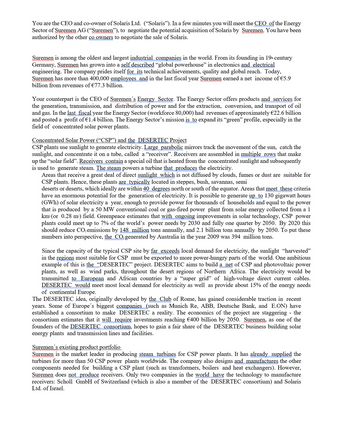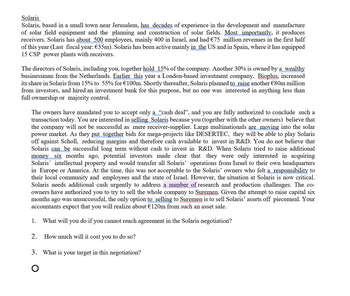
Principles Of Marketing
17th Edition
ISBN: 9780134492513
Author: Kotler, Philip, Armstrong, Gary (gary M.)
Publisher: Pearson Higher Education,
expand_more
expand_more
format_list_bulleted
Question
Read the passage that attached and answer the following questions. I am the SELLER in this situation.
- What do you think that the most important issues are for your counterparty in the negotiation?
- What do you think is your counterparty’s BATNA? Reservation price? Target?
- What parts of the scenario work in your counterparty’s favor?

Transcribed Image Text:You are the CEO and co-owner of Solaris Ltd. ("Solaris"). In a few minutes you will meet the CEO of the Energy
Sector of Suremen AG (“Suremen”), to negotiate the potential acquisition of Solaris by Suremen. You have been
authorized by the other co owners to negotiate the sale of Solaris.
Suremen is among the oldest and largest industrial companies in the world. From its founding in 19th century
Germany, Suremen has grown into a self described "global powerhouse" in electronics and electrical
engineering. The company prides itself for its technical achievements, quality and global reach. Today,
Suremen has more than 400,000 employees and in the last fiscal year Suremen earned a net income of €5.9
billion from revenues of €77.3 billion.
Your counterpart is the CEO of Suremen's Energy Sector. The Energy Sector offers products and services for
the generation, transmission, and distribution of power and for the extraction, conversion, and transport of oil
and gas. In the last fiscal year the Energy Sector (workforce 80,000) had revenues of approximately €22.6 billion
and posted a profit of €1.4 billion. The Energy Sector's mission is to expand its "green" profile, especially in the
field of concentrated solar power plants.
Concentrated Solar Power ("CSP") and the_DESERTEC Project
CSP plants use sunlight to generate electricity. Large_parabolic mirrors track the movement of the sun, catch the
sunlight, and concentrate it on a tube, called a "receiver". Receivers are assembled in multiple rows that make
up the "solar field”. Receivers contain a special oil that is heated from the concentrated sunlight and subsequently
is used to generate steam. The steam powers a turbine that produces the electricity.
Areas that receive a great deal of direct sunlight which is not diffused by clouds, fumes or dust are suitable for
CSP plants. Hence, these plants are typically located in steppes, bush, savannas, semi
deserts or deserts, which ideally are within 40 degrees north or south of the equator. Areas that meet these criteria
have an enormous potential for the generation of electricity. It is possible to generate up to 130 gigawatt hours
(GWh) of solar electricity a year, enough to provide power for thousands of households and equal to the power
that is produced by a 50 MW conventional coal or gas-fired power plant from solar energy collected from a 1
km² (or 0.28 m²) field. Greenpeace estimates that with ongoing improvements in solar technology, CSP power
plants could meet up to 7% of the world's power needs by 2030 and fully one quarter by 2050. By 2020 this
should reduce CO₂ emissions by 148 million tons annually, and 2.1 billion tons annually by 2050. To put these
numbers into perspective, the CO₂ generated by Australia in the year 2009 was 394 million tons.
Since the capacity of the typical CSP site by far exceeds local demand for electricity, the sunlight "harvested"
in the regions most suitable for CSP must be exported to more power-hungry parts of the world. One ambitious
example of this is the “DESERTEC” project. DESERTEC aims to build a net of CSP and photovoltaic power
plants, as well as wind parks, throughout the desert regions of Northern Africa. The electricity would be
transmitted to European and African countries by a "super grid" of high-voltage direct current cables.
DESERTEC would meet most local demand for electricity as well as provide about 15% of the energy needs
of continental Europe.
The DESERTEC idea, originally developed by the Club of Rome, has gained considerable traction in recent
years. Some of Europe's biggest companies (such as Munich Re, ABB, Deutsche Bank, and E.ON) have
established a consortium to make DESERTEC a reality. The economics of the project are staggering - the
consortium estimates that it will require investments reaching €400 billion by 2050. Suremen, as one of the
founders of the DESERTEC consortium, hopes to gain a fair share of the DESERTEC business building solar
energy plants and transmission lines and facilities.
Suremen's existing product portfolio
Suremen is the market leader in producing steam turbines for CSP power plants. It has already supplied the
turbines for more than 50 CSP power plants worldwide. The company also designs and manufactures the other
components needed for building a CSP plant (such as transformers, boilers and heat exchangers). However,
Suremen does not produce receivers. Only two companies in the world have the technology to manufacture
receivers: Scholl GmbH of Switzerland (which is also a member of the DESERTEC consortium) and Solaris
Ltd. of Israel.

Transcribed Image Text:Solaris
Solaris, based in a small town near Jerusalem, has decades of experience in the development and manufacture
of solar field equipment and the planning and construction of solar fields. Most importantly, it produces
receivers. Solaris has about 500 employees, mainly 400 in Israel, and had €75 million revenues in the first half
of this year (Last fiscal year: €35m). Solaris has been active mainly in the US and in Spain, where it has equipped
15 CSP power plants with receivers.
The directors of Solaris, including you, together hold 15% of the company. Another 30% is owned by a wealthy
businessman from the Netherlands. Earlier this year a London-based investment company, Bioplus, increased
its share in Solaris from 15% to 55% for €100m. Shortly thereafter, Solaris planned to raise another €80m million
from investors, and hired an investment bank for this purpose, but no one was interested in anything less than
full ownership or majority control.
The owners have mandated you to accept only a "cash deal", and you are fully authorized to conclude such a
transaction today. You are interested in selling Solaris because you (together with the other owners) believe that
the company will not be successful as mere receiver-supplier. Large multinationals are moving into the solar
power market. As they put together bids for mega-projects like DESERTEC, they will be able to play Solaris
off against Scholl, reducing margins and therefore cash available to invest in R&D. You do not believe that
Solaris can be successful long term without cash to invest in R&D. When Solaris tried to raise additional
money six months ago, potential investors made clear that they were only interested in acquiring
Solaris intellectual property and would transfer all Solaris' operations from Israel to their own headquarters
in Europe or America. At the time, this was not acceptable to the Solaris' owners who felt a responsibility to
their local community and employees and the state of Israel. However, the situation at Solaris is now critical.
Solaris needs additional cash urgently to address a number of research and production challenges. The co-
owners have authorized you to try to sell the whole company to Suremen. Given the attempt to raise capital six
months ago was unsuccessful, the only option to selling to Suremen is to sell Solaris' assets off piecemeal. Your
accountants expect that you will realize about €120m from such an asset sale.
1. What will you do if
2.
you cannot reach agreement in the Solaris negotiation?
How much will it cost you to do so?
3. What is your target in this negotiation?
Expert Solution
This question has been solved!
Explore an expertly crafted, step-by-step solution for a thorough understanding of key concepts.
Step by stepSolved in 3 steps

Knowledge Booster
Similar questions
- What are the six standard export documents? For each standard export document, who prepares it, who receives it, and what purpose does it serve? What common information do many standard export documents share? Besides the six standard export documents, identify five other export documents. Under what circumstances might these other export documents be required? For each other export document, who prepares it and what purpose does it serve?arrow_forwardComment on the limitations encountered along the supply chain of natural gas and liquified natural gas (LNG) and their effect on the prices, and the present and future trading trends for these commodities.arrow_forwardHi, please read the attachment and answer the questions below. I am the buyer in this negotiation. What strategies will you be using in the negotiation? Do you want to make the opening offer? Why or why not? What strategies do you expect to see from your counterparty? How will you prepare to meet those strategies? Given your scenario, what other information is important for you to keep in mind while negotiating?arrow_forward
- what is zone of possible agreement (ZOPA)arrow_forwardHi, please read the attachment and answer the questions below. I am the buyer in this negotiation. What do you think that the most important issues are for your counterparty in the negotiation? What do you think is your counterparty’s BATNA? Reservation price? Target? What parts of the scenario work in your counterparty’s favor?arrow_forwardDo problem 2 letter garrow_forward
arrow_back_ios
arrow_forward_ios
Recommended textbooks for you
 Principles Of MarketingMarketingISBN:9780134492513Author:Kotler, Philip, Armstrong, Gary (gary M.)Publisher:Pearson Higher Education,
Principles Of MarketingMarketingISBN:9780134492513Author:Kotler, Philip, Armstrong, Gary (gary M.)Publisher:Pearson Higher Education, MarketingMarketingISBN:9781259924040Author:Roger A. Kerin, Steven W. HartleyPublisher:McGraw-Hill Education
MarketingMarketingISBN:9781259924040Author:Roger A. Kerin, Steven W. HartleyPublisher:McGraw-Hill Education Foundations of Business (MindTap Course List)MarketingISBN:9781337386920Author:William M. Pride, Robert J. Hughes, Jack R. KapoorPublisher:Cengage Learning
Foundations of Business (MindTap Course List)MarketingISBN:9781337386920Author:William M. Pride, Robert J. Hughes, Jack R. KapoorPublisher:Cengage Learning Marketing: An Introduction (13th Edition)MarketingISBN:9780134149530Author:Gary Armstrong, Philip KotlerPublisher:PEARSON
Marketing: An Introduction (13th Edition)MarketingISBN:9780134149530Author:Gary Armstrong, Philip KotlerPublisher:PEARSON
 Contemporary MarketingMarketingISBN:9780357033777Author:Louis E. Boone, David L. KurtzPublisher:Cengage Learning
Contemporary MarketingMarketingISBN:9780357033777Author:Louis E. Boone, David L. KurtzPublisher:Cengage Learning

Principles Of Marketing
Marketing
ISBN:9780134492513
Author:Kotler, Philip, Armstrong, Gary (gary M.)
Publisher:Pearson Higher Education,

Marketing
Marketing
ISBN:9781259924040
Author:Roger A. Kerin, Steven W. Hartley
Publisher:McGraw-Hill Education

Foundations of Business (MindTap Course List)
Marketing
ISBN:9781337386920
Author:William M. Pride, Robert J. Hughes, Jack R. Kapoor
Publisher:Cengage Learning

Marketing: An Introduction (13th Edition)
Marketing
ISBN:9780134149530
Author:Gary Armstrong, Philip Kotler
Publisher:PEARSON


Contemporary Marketing
Marketing
ISBN:9780357033777
Author:Louis E. Boone, David L. Kurtz
Publisher:Cengage Learning